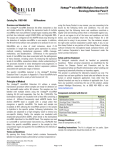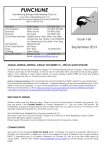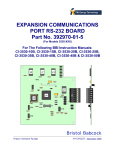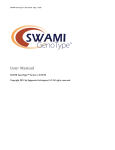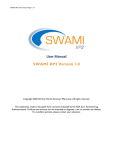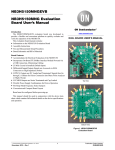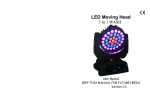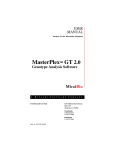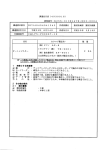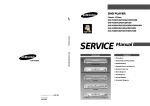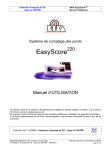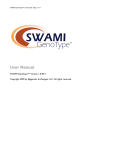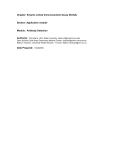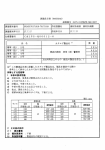Download Signet Y-SNP Identification System
Transcript
Important Information The product you have received is authorized for laboratory research use only. The product has not been qualified or found safe and effective for any human or animal diagnostic or therapeutic application. Uses other than the labeled intended use may be a violation of applicable law. Precautions Signet™ Y-SNP Identification System v2.0 Y-SNP Genotyping Core Kit The Signet Y-SNP Identification System v2.0 comprises a core detection kit, a broad screening kit, and eleven individual genotyping kits. The Core Kit contains the Control DNAs, Exonuclease, 5x Labeling Mix, and Hybridization Solution. The screening and typing kits contain the specific 2X PCR Mixes and Bead Mixes necessary to complete the analysis. All kits are for 100 Reactions. Warning: This product contains hazardous reagents. It is the end-user’s responsibility to consult the applicable MSDS(s) before using this product. Disposal of waste organics, acids, bases, and radioactive materials must comply with all appropriate federal, state, and local regulations. If you have any questions concerning the hazards associated with this product, please call Marligen Biosciences, Inc at (301)874-4990. Trademarks Signet™ is a trademark of Marligen Biosciences, Inc. xMAP™ and Luminex® are trademarks of Luminex Corporation. MasterPlex™ is a trademark of MiraiBio, Inc. AmpliTaq Gold® is a trademark of Applera Corporation. Platinum® is a trademark of Invitrogen Corporation. Introduction to Signet™ Products Signet products and reagents are based on xMAP™ Suspension Array Technology. DNA samples are amplified by PCR and labeled with a fluorescent tag. The fluorescently labeled products are then hybridized to an array of allele-specific oligonucleotides immobilized on latex beads. Each bead is identified by a unique spectral address (color). After hybridization, the Bead Mix is analyzed by the Luminex® 100 system that records the spectral address of the bead and the amount of fluorescent tag bound to it. Genotype reports can be generated by computer using a software package such as MasterPlex™ GT from MiraiBio. Name Cat. # Name Cat. # Y-SNP Genotyping Core Kit 11710-100 Y-SNP KLMN Genotyping Kit 11717-100 Y-SNP Primary Screening Kit 11711-100 Y-SNP O1 Genotyping Kit 11718-100 Y-SNP AB Genotyping Kit 11712-100 Y-SNP O2 Genotyping Kit 11719-100 Y-SNP CD Genotyping Kit 11713-100 Y-SNP PQ Genotyping Kit 11720-100 Y-SNP E Genotyping Kit 11714-100 Y-SNP R1 Genotyping Kit 11721-100 The Marligen Y-SNP Identification System is designed to determine the genotype of human male Y chromosomes. Five simple steps comprise the assay: Y-SNP FGHI Genotyping Kit 11715-100 Y-SNP R2 Genotyping Kit 11722-100 1. Amplify the polymorphic Y-chromosome loci by multiplexed PCR. Y-SNP J Genotyping Kit 11716-100 2. Remove the PCR primers by incubating with Exonuclease I. 3. Label the PCR products by extension from a fluorescently-tagged oligonucleotide. 4. Hybridize the labeled DNA with allele-specific oligonucleotides in a Bead Mix array. 5. Read the hybridized microspheres in a Luminex 100 System Note for customers familiar with Marligen Signet products: please pay attention to changes in the protocol! An extensive Y-SNP bibliography and Y-SNP Haplotype Map are available from Marligen upon request from technical.service @Marligen.com Overview The Y-SNPs used to genotype the Y-chromosome are grouped into 12 multiplexes for highly efficient determination of a Y-chromosome genotype. The multiplexes are summarized in Table 1. [ 2] To Order: 866.464.4900 301.874.4990 [email protected] To Order: 866.464.4900 301.874.4990 [email protected] Table 1: Polymorphic loci in the Y-SNP Identification System and their multiplex assignments Multiplex A-R AB CD E FGHI J Multiplex description Screening Multiplex African, 168C Asian, M168T/ M89C/M96G African, M Eastern, M96C Eurasian M89T/ M9G/ M304A M Eastern M304C Variants M9 M45 M89 M96 M122 M168 M175 M207 M304 M343 AmelXY M31 M32 M42 M150 M146 M182 P4 M15 M38 M48 M55 M125 M130 M131 M145 M151 M210 M217 DYS391 M2 M33 M35 M58 M75 M78 M81 M123 M26 M52 M170 M201 M253 P15 P16 P37 M47 M67 M92 M172 M241 M267 KLMN O1 O2 PQ R1 R2 Eurasian, M9C/ M45G/ M175+ SE-Asian, M175-/ M122T SE-Asian, M175-/ M122C Asian, Native American M45A/M207 A IndoEuropean, M207G/M34 3C IndoEuropean, M343A M5 M11 M70 M178 M214 M231 SRY9138 Tat M88 M95 M101 M103 M119 P31 SRY465 M7 M113 M117 M121 M134 M159 M164 M3 M19 M120 M143 M194 M199 M242 M323 M17 M56 M87 M124 M157 M173 SRY10831 M18 M37 M65 M126 M153 M269 P25 SRY-2627 Multiplex Multiplex description Variants Additional Materials Required • • • • • • Hot-start Taq DNA Polymerase (AmpliTaq Gold® from Applied Biosystems or Platinum® Taq from Invitrogen) Taq Polymerase Water bath sonicator Vortex mixer Luminex 100 System with temperature controlled XY platform 96-well PCR plate and plate sealer or PCR tubes with caps Temperature-controlled block for 96-well plate set to 55ºC (Optional) [ 3] To Order: 866.464.4900 301.874.4990 [email protected] When you receive your Signet Y-SNP Identification System you may store the entire kit at –20°C. However, prior to first use of the kit the components must be separated and stored under different conditions. Core Kit Components Recommended Storage Y-SNP Labeling Mix 100 μl -20ºC, protect from light 500 μl -20ºC 100 μl Exonuclease I Hybridization Solution Volume -20°C 9947A and 9948 DNA Screening and Genotyping Kit Components The Multiplex A-R SNPs define major groupings of Y haplogroups. On samples of unknown origin, it is recommended to first test the samples with the screening multiplex A-R to determine the Yhaplogroups of the samples. The genotype can then be determined by subsequent testing with one of the Haplogroup-specific multiplexes. • Storage of Components Room Temperature Recommended Storage Y-SNP 2X PCR Mixes -20°C, PCR set-up lab Y-SNP Bead Mixes +4°C, protect from light 7 ml Volume 1 ml 200 μl General Precautions Light Sensitivity The Labeling Mix and Bead Mixes in this product contain fluorescent dyes that are light-sensitive. It is safe to use these items in normal laboratory fluorescent lighting. They should be covered and kept in a dark location when not in use. Aluminum foil is useful for creating temporary light shields. A drawer or darkened cabinet is also useful for short-term storage during use. Bead Settling Beads are 5.6 microns in diameter and are slightly more dense than water. They will settle gradually and should be mixed just prior to any pipetting step. Brief vortexing is sufficient for mixing suspensions that have settled for just a few minutes. Upon storage for several hours, small clumps of beads form that should be disrupted by sonication in a water bath. The Luminex 100 has a mixing function built into it that briefly injects a few microliters of sheath fluid prior to analyzing a sample. Therefore, disruption is not necessary during the plate reading. Critical Parameters • Use volumes precisely as indicated in the protocol • Protect Labeling Mix and Bead Mixes from light • Mix beads thoroughly to ensure a uniform suspension • Mix PCR and Labeling Reagent by vortexing prior to use [ 4] To Order: 866.464.4900 301.874.4990 [email protected] NOTE: The procedure requires a hot-start PCR protocol. We recommend use of Platinum Taq from Invitrogen. PROTOCOL I. Before beginning The use of gloves and aerosol-resistant pipet tips is highly recommended. Keep preamplification and post-amplification reagents in separate rooms. 1) 2) Select the multiplexes to analyze. On samples of unknown origin, it is recommended to first test the samples with the screening multiplex A-R to determine the Y-haplogroups of the samples. The genotype is then determined by subsequent testing with one of the Haplogroup-specific multiplexes. Different multiplexes may be run on the same PCR plate. Check the Hybridization Solution for precipitate. If a precipitate is present, heat the Hybridization at 55ºC and mix until dissolved. 4) Determine the number of reactions to be set up. This should include a reagent blank (no DNA and no Taq Polymerase), a negative control (no DNA added but with Taq), and male DNA (9948) and female DNA (9947A) controls. Male DNA will yield a full profile, while female DNA will only give signal on the amelogenin X bead in Multiplex 1. Add 1 or 2 reactions to the total number of reactions to compensate for losses during pipetting. This will ensure that enough master mix is available for all samples in the experiment. II. Amplify Y-chromosome DNA 4) For the negative control, pipette nuclease-free water instead of DNA into the appropriate wells or tubes. 5) Pipette the appropriate volume of master mix into the wells or tubes. 6) Cap or seal the PCR plate, and place in a thermocycler. 7) Run the following Amplification Program The duration of the initial 94ºC step should be adjusted according to the instructions provided by the manufacturer of the Taq polymerase. Initial Denaturation Amplification: 30 cycles Final Extension and Hold Y-SNP 2X PCR Mix Taq DNA Polymerase (5 U/μl) Control or test DNA Deionized H2O Amount per Reaction X Number Of Reactions Final Volume 10 μl 0.4 μl 1-10 μl (1-10 ng) 0-9 μl (To make 20 μl total volume) Prepare the master mixes by pipetting the volumes of everything except sample from the above table into 1.5 or 2 ml polypropylene tubes. Mix gently. [ 5] To Order: 866.464.4900 301.874.4990 [email protected] 94ºC 94ºC 58ºC 72ºC 72ºC 5ºC Per manufacturer’s instructions 30 sec 20 sec 90 sec 3 min Hold Samples may be stored overnight at 4ºC after the amplification step. NOTE: If high sensitivity is not required, use ½ the recommended amount of Taq polymerase amount with the same reaction volume and/or scale the reaction to a final volume of 10 ul. Significant cost savings can be achieved with minimal reduction in sensitivity. 8) Remove primers with Exonuclease I Add 1 μl Exonuclease I to each amplification reaction and mix thoroughly. Incubate at 37ºC for 30 min. Inactivate the enzyme by heating at 80ºC for 20 min. This step may be done conveniently in the thermal cycler. Calculate the volumes of reagents needed for the master mix using the table below: Component 2) Add 1-10 μl of each DNA sample (containing 1-8 ng) into a well or tube. Thaw the Y-SNP PCR Mixes. It is very important to vortex the Y-SNP PCR mixes thoroughly for 5-10 seconds prior to each use. This dissolves any precipitate that may form during each freeze-thaw cycle. 3) 1) 3) III. Label the amplified DNA A fluorescent tag is incorporated into the amplicons using Taq polymerase in a cycled primer extension reaction. Set these reactions up in a clean 96-well PCR plate. The total reaction volume of each well or tube is 25 μl. NOTE: The Labeling Solution is light sensitive. Keep shielded from light. 1) Thaw the Y-SNP Labeling Mix. It is very important to vortex the Y-SNP Labeling Mix thoroughly for 5-10 seconds prior to each use to dissolve any precipitate that may form during each freeze-thaw cycle 2) Calculate the amount of Labeling Master Mix components that will be needed using the table below, adding one or two extra reactions to your calculation to ensure that [ 6] To Order: 866.464.4900 301.874.4990 [email protected] checked, the Set Point is 55ºC, and the aluminum 96-well plate holder is present in the XY platform. you have sufficient volume. The same Y-SNP Labeling Mix is used for all of the multiplexes. Y-SNP Labeling Master Mix: Component diH2O Y-SNP Labeling Mix Taq DNA Polymerase (5 U/μl) Amount per Reaction 18.75 μl 5 μl 0.25 μl X Number of Reactions Final Volume 3) Prepare the labeling master mix by pipetting the volumes of all components above into a sterile polypropylene tube. Mix gently. 4) Pipet 24 μl labeling master mix into the required number of sample and control wells or PCR tubes. 5) Add 1 μl PCR product to each well containing labeling master mix. 6) Cap or seal the PCR plate or tubes and place in a thermal cycler. 7) Run the following Labeling Program. Please note that the annealing temperature is 55ºC rather than 58ºC. Initial Denaturation Amplification: 40 cycles Final Extension and Hold 94ºC 94ºC 55ºC 72ºC 72ºC 5ºC Per manufacturer’s instructions 30 sec 30 sec 30 sec 3 min Hold NOTE: The Luminex 100 XY platform is required for this procedure. Make certain that the aluminum 96-well plate holder is installed and is pre-heated to 55ºC. NOTE: The Bead Mixes are light sensitive. whenever they are not in use. Protect Bead Mixes from the light 2) Add 35 μl Hybridization Solution to each well of the Costar 6509 96-well plate beginning at A1 and then continuing column-by-column until complete (B1-H1 followed by A2-H2, etc.). 3) Transfer the labeled PCR product into wells containing Hybridization Solution. Be certain to include the reagent blank controls and note their position. A reagent blank will be used as part of the machine set-up. Add the remaining samples column-by-column (A1-H1, followed by A2-H2, etc.) Place the plate into the preheated block of the Luminex 100 XY Platform and incubate at 55ºC while preparing Hybridization Bead Mix. 4) Resuspend the Bead Mix by vortexing for 15-20 seconds. Sonicate the suspension in a water bath sonicator for 2 minutes to create a single-sphere suspension. 5) In a capped polypropylene tube prepare a Hybridization Bead Mix by adding 2 μl resuspended Y-SNP Bead Mix to 35 μl of Hybridization Solution for each reaction. Make sufficient Hybridization Bead Mix for 1-2 more reactions than the number you will be setting up. Disperse the beads in the Hybridization Bead Mix by vortexing 15-20 seconds and then sonicating for 1 minute. 6) Add 37 μl of the Hybridization Bead Mix mixture to wells of the microtiter plate containing PCR product from the matching multiplex. 7) Hybridize at 55°C for 30 minutes. Protect samples from light. Samples may be stored overnight at -20ºC after labeling. V. Read in Luminex 100 System IV. Hybridize to Beads Detailed instructions on hardware and software operations are provided in the Luminex 100 User’s Manual. The following is an abbreviated protocol specific for the Signet YSNP Identification System. For the bead map, please see the file available on Marligen’s The Signet™ Y-SNP Identification System contains Y-SNP Bead Mixes that match the PCR mixes. Make certain that a bead master mix is made for each multiplex or combination of multiplexes that were amplified. Different multiplexes may be analyzed in the same plate. 1) Warm up the Luminex 100 reader. Follow the manufacturer’s instructions for preparing and calibrating the instrument. Using the Luminex Data Collector software, set the temperature of the XY platform to 55ºC. Click on the Options icon followed by the Setup XY tab. Make certain that the “Heater Enabled” box is [ 7] To Order: 866.464.4900 301.874.4990 [email protected] web site at www.marligen.com. 1) The Luminex 100 should have been prepared before the hybridization step. A new session must be defined and the correct template loaded. a) From the Luminex Data Collector screen, click Template on the toolbar. b) A dialog box will appear. Select Signet Y-chromosome DNA II and click “OK”. [ 8] To Order: 866.464.4900 301.874.4990 [email protected] NOTE: If Signet Y-chromosome DNA II does not appear on your list of templates, contact Marligen by e-mail at [email protected]. The template and installation instructions will be sent to you via e-mail. Experienced users may use the bead map information from the Excel spreadsheet to key in their own template. c) A new dialog box will appear. Enter a name to identify this session on the New Folder line and click OK. d) The main session screen will appear. Click on the Setting button. A dialog box will appear. Enter the exact number of samples. The operator name may also be entered. The name of the session will appear in the Description box. All of the other boxes contain information specified in the template: e) Events: 150x (the number of beads) Total (i. e., 1500 total for J, 3300 total for A-R, etc.) Sample size: 75 μl Min events: 20 Flow rate: fast Do not change any of these values. Click OK to save the completed settings. f) The main session screen should now contain a row for every sample. Descriptions of the samples may be entered by double-clicking on the individual cell and typing in the information. 2) Place samples in the XY tray. Fill the reservoir with sheath fluid and retract. 3) Run one wash cycle. 4) Check the Single box under the Start button. Make certain that the reagent blank is highlighted, and then click Start. 5) The instrument will read the “Bead Only” sample in well A1. 6) Use the data from the reagent blank to set the gate a) Make sure that the X-axis of the histogram in the lower left corner is set to Doublet Discriminator b) Right-click on the histogram. A pull-down menu appears c) Scroll to Gate and follow the arrow to the right. d) Click Create. Dotted, vertical red lines appear in the histogram frame. e) With the mouse, drag each line to closely bracket the main peak. It is most important to keep the gate tight on the right-hand side, since this will eliminate microsphere doublets from the analysis. [ 9] To Order: 866.464.4900 301.874.4990 [email protected] 7) Clear the Single box under the Start button. Make certain that the B1 row is highlighted, then click Start. The Luminex 100 will read the rest of the samples automatically. 8) After data collection is complete, select Save on the File menu. The data will be saved in the newly created session folder. NOTE: If this step is omitted all data will be lost! INTERPRETING RESULTS The use of MasterPlex GT software from MiraiBio for data analysis is strongly recommended. MasterPlex GT conveniently automates the analysis of the output files produced by the Luminex Data Collector software. The main output file of Luminex Data Collect is called “Output.csv” and is located in the session folder that was named during session setup. Output.csv may also be imported into Microsoft Excel or similar spreadsheet programs for manual analysis. The following parameters are recommended for data analysis with MasterPlex GT or for manual data analysis: 1) Use the PCR reaction(s) without Taq polymerase as the negative controls. This will ensure that the reagent background is subtracted from the data. 2) The minimum number of events (the threshold number of beads that must be recorded) should have a value of at least 20. This will avoid chatter generated by small numbers of stray microspheres. 3) Use the “relative intensity” for allele calling. To calculate the relative intensity of each allele, the MFI of the allele is divided by the sum of the MFI of both alleles: RIA allele = MFIA allele/(MFIA allele+MFIB allele). 4) Figure 1 shows the raw MFI data from 85 individuals at the M2 locus, collected on different days, machines, analysts, and DNA inputs. Although the MFI values vary considerably, the values cluster tightly around lines that correspond to a relative intensity of 88% for the G allele or a relative intensity of 68% for the A allele. [10] To Order: 866.464.4900 301.874.4990 [email protected] 7) Hybridization at Locus M2 350 RI “G” Allele = 85% Figure 3 shows the genotyping result for the same test DNA sample tested with the KLMN multiplex. The results show that the sample is M214C/M231A/TatC/M178T, i. e., its haplotype is N3a. MFI M2 A Allele 300 250 200 150 100 RI “A” Allele = 68% 50 0 0 50 100 150 200 250 300 350 MFI M2 G Allele Figure 1. Raw MFI signals at locus M2. Although MFI levels can vary, relative intensity levels are nearly constant for each allele. 5) 6) The intensity threshold should be set to at least 20. Beads with a median fluorescent intensity (MFI) less than 20 will not be reported as an allele. Samples with low intensity in all allelic forms (such as female DNA) will be reported as a null or no-call. Figure 2 shows an example genotyping result for a test DNA that was tested with multiplex A-R. The results show that the sample is M9C/M45G/M175ins, therefore, this sample needs to be typed further with the KLMN multiplex. Figure 2. Plot of Relative Intensity for the alleles of a Test DNA sample with the A-R multiplex. The sample type is M9C/M45G/M175ins, therefore, this sample needs to be typed further with the KLMN multiplex. [11] To Order: 866.464.4900 301.874.4990 [email protected] Figure 3. Plot of Relative Intensity for the alleles of a Test DNA sample with the KLMN multiplex. The sample has been typed as M214C/M231A/TatC/M178T, and its haplotype is N3a. Notes on some individual markers: 1. Assays for some rare markers had been verified for the ancestral alleles only 2. P25 is a multi-loci marker and will normally give a signal for both alleles. Users should call alleles by the C to A signal ratio, relying on the 9948 Control DNA, which is P25A (The haplotype of 9948 Control DNA is R1b3*). The signal ratio (C to A) for P25 marker is approx. 50:50 for A allele, or 60:40 for C allele. 3. The P37 allele may generate a signal with female DNA samples due to crossreactive sequences in the female genome. However, the results for P37 will be accurate when the sample comprises only male DNA. 4. The assay for M17 will always develop strong signal for the del allele. The signal for the ins allele is negligible for the del type samples, or approx. 40% for the ins type samples. Contact Us: Marligen Biosciences, Inc. 2502 Urbana Pike Ijamsville, MD 21754 301-874-4990 301-874-4993 (fax) www.marligen.com [12] To Order: 866.464.4900 301.874.4990 [email protected] 20109 rev. 081905






